Fiction as practice
symbiosishood << / >> thingswhichnecrose
Click
to access /
![]() ...........
Last Venice Biennale of Architecture / International Pavilion, Arsenal / Venice / 2010
/ Curator K. Sejima
...........
Last Venice Biennale of Architecture / International Pavilion, Arsenal / Venice / 2010
/ Curator K. Sejima
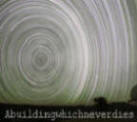
theBuildingWhichNeverDies (tBWND)
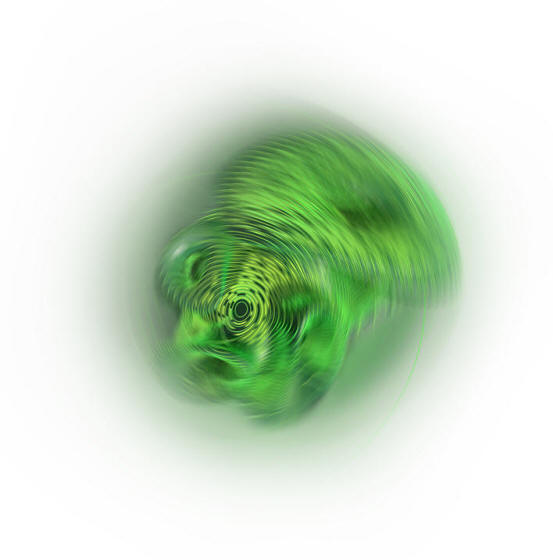

A nocturnal observatory pivoting on itself, this research laboratory is intended to analyze human beings’ physiological and ocular adaptation to the dark, in order to be able to reduce urban light pollution. This lab is aimed at the moon when it’s above the horizon, to take advantage of the one-lux minimum moonlight and even amplify it. At night this lab restores the light intensity of daytime by discharging UV sensor units located on all the exterior surfaces. Their phosphorescent components (uranium oxide pigment) thus report on solar activity and its degree of dangerousness, and variations of intensity according to the areas affected by direct sunlight.
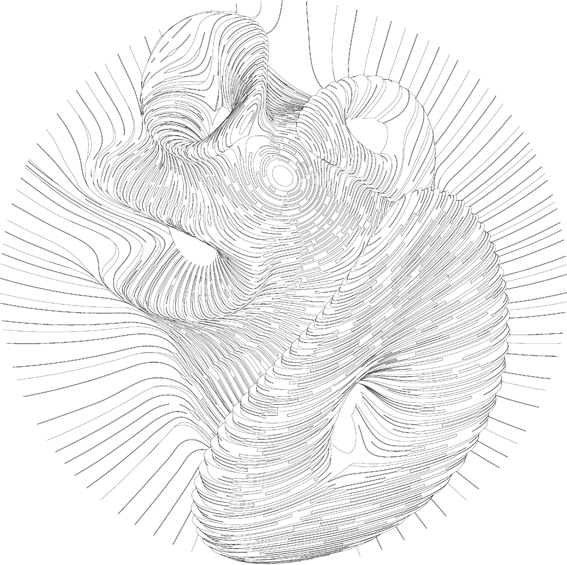
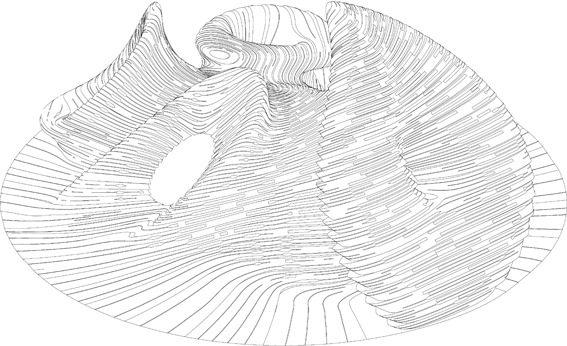


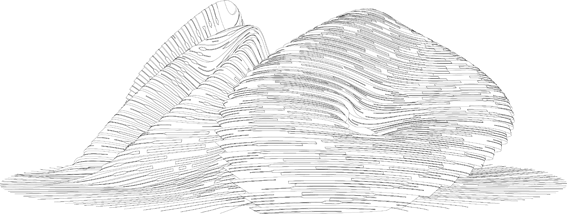
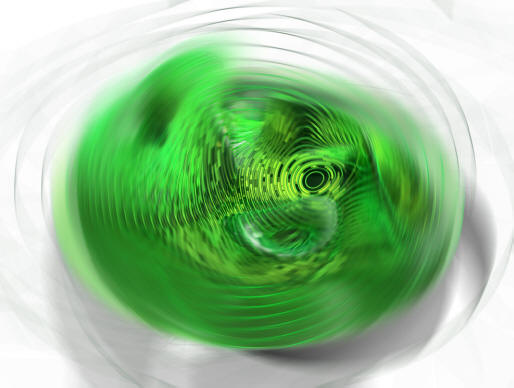
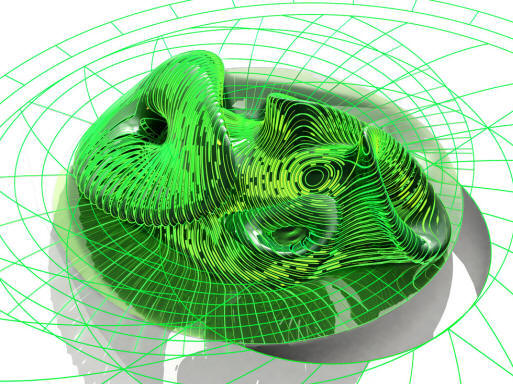
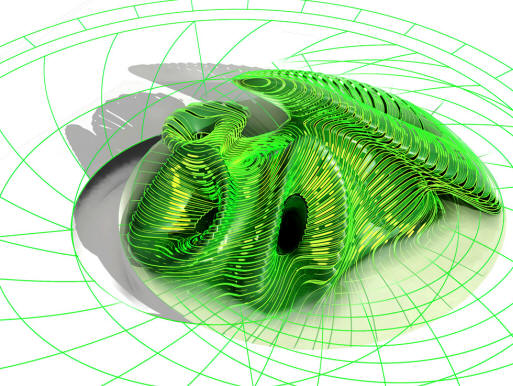
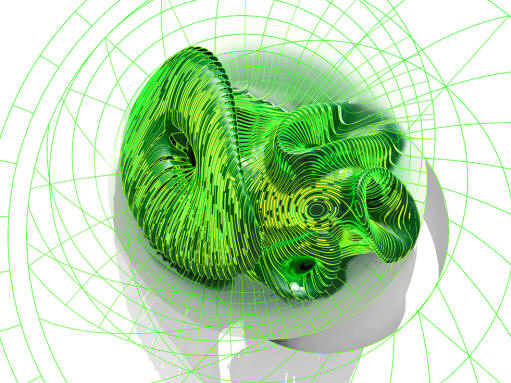
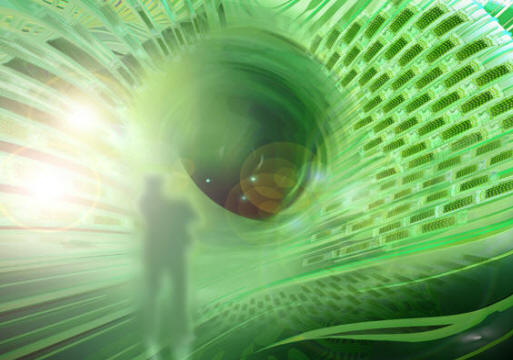
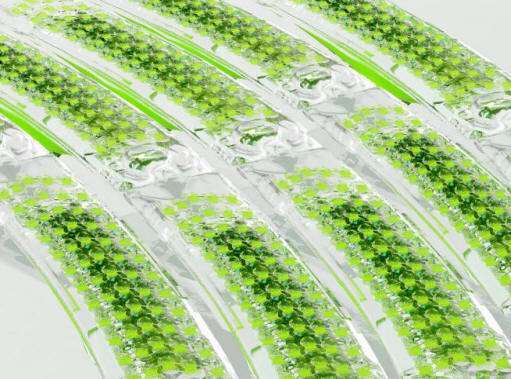
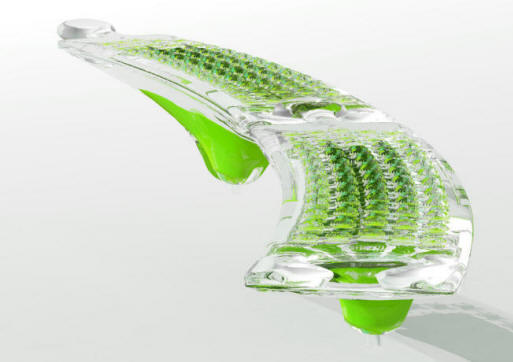
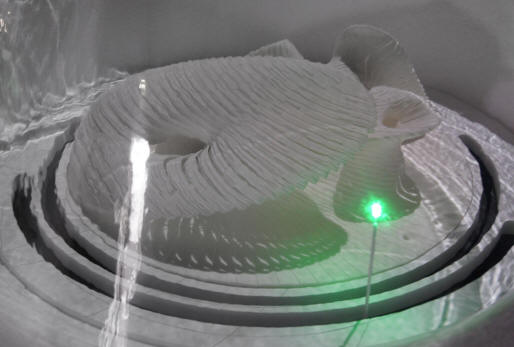

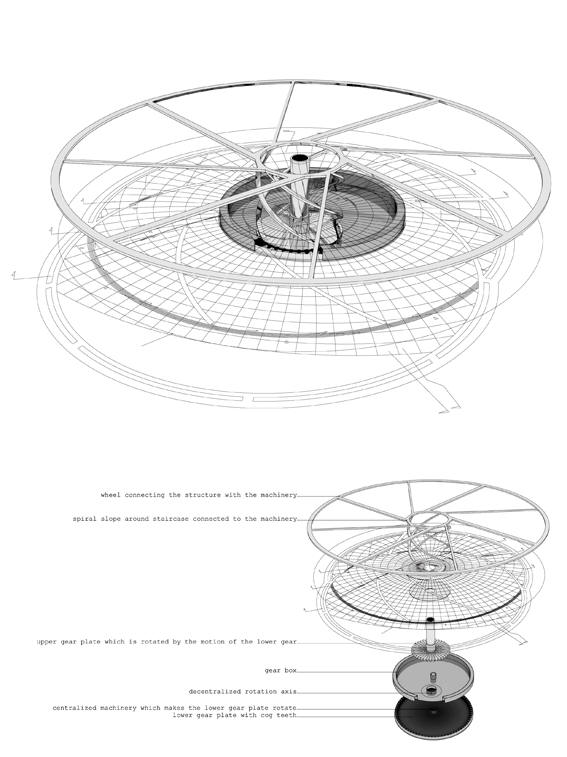

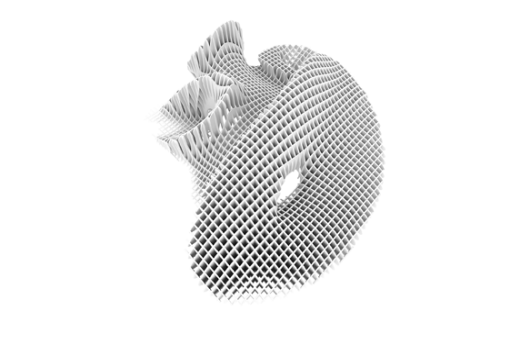
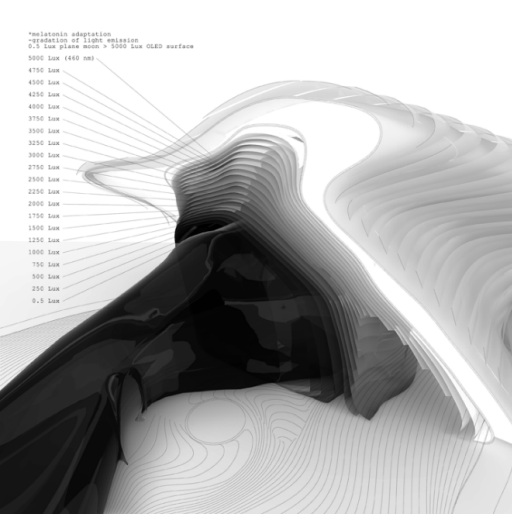

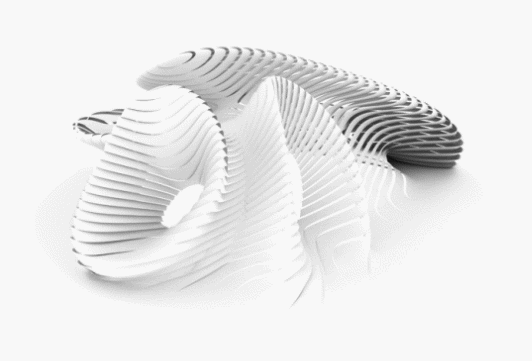
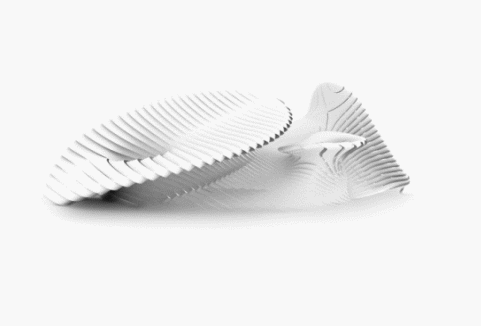


--------------
Walking on the moon
I was plugged into the shadows of the day, in the death of the sunset, inter canem et lupum*. It was in this state that I arrived in a twilight zone, located to the west of Paris, before reaching the flat horizon of the Atlantic coast, in a spot called Les Andelys.
A scientist of light phenomena, living and working in Les Andelys, had called me a week before. I perceived in his voice both childlike enthusiasm and a fear of the unknown. He was unwilling to discuss his most recent experiments over the phone, insisting instead upon a physical encounter.
From a traffic jam at the exit of Paris, to a "cats and dogs" downpour on the motorway, I arrived late, at the end of the day. As an arrival protocol, the scientist had instructed me to complete the final 200m of my journey on foot. I observed this condition, noting as I walked, the saturation of the air with moisture and the fog of Normandy.
In the car park, at a distance from the site, I noted the waxing of a surreal moon, glowing green in the night sky. Using a simple principle of blur logic, I tried to describe in my mind the unreadable silhouette emerging from the fog. At this point of blurriness, the novel by Edgar Alan Poe, "The Narrative of A. Gordon Pym of Nantucket", came back to me, and specifically the unfinished end:
"March 22nd. The darkness had materially increased, relieved only by the glare of the water thrown back from the white curtain before us… …Hereupon Nu-Nu stirred in the bottom of the boat; but upon touching him we found his spirit departed. And now we rushed into the embraces of the cataract, where a chasm threw itself open to receive us. But there arose in our pathway a shrouded human figure, very far larger in its proportions than any dweller among men. And the hue of the skin of the figure was of the perfect whiteness of the snow…
In Les Andelys, this silhouette could be perceived as an afterglow sensation, as a phosphorescence of the death of daylight. In front of me I perceived a multitude of bright curves, reminiscent of long-exposure photography that transforms the stars in the night sky into staggered white threads.
As I approached, these linear fireflies became a multitude of sophisticated hybrid glass components, populating the surfaces of the building like the photosynthetic derma of a plant. Wrapped by the glowing lines of the entrance, the scientist was waiting for me with a worrying, endless black corridor – a "Lost Highway" of David Lynch – at his back. He invited me to penetrate into the layered darkness, but with a mischievous air suggested that I should go first into the darkness, into the unknown…
The phosphorescence gradually decreased and become a lost sensation on my back. I was cautiously absorbed by the interior night, my perception switched off; the blackness became a tangible substance through which slowly, by incremental steps, some fictional twisted vision of the moon, through a deformed lens, real and unreal, reappeared as a visual whispering. I was not so astonished by my new ability to distinguish details in the dark, but was surprised that the dimmable adaptability of my metabolism had become the subject of the experiment. The multiple reflections of the moon rippling on all the boundaries of the space helped me to tame the night. Just to reassure you, I was still human, without the hairiness of a werewolf…
Traversing the nadir of the darkened space, we progressed towards the "circadian onion" where the darkened light conditions graduated incrementally towards an inverse condition of artificial light. At the boundary of this stratification, I arrived at the brilliant immersion zone, bathing in pure luminescent space, where the light seemed to come directly from any surface, without bulb or point source, just light as a material - as a pure substance.
I observed, almost imperceptibly, the altering state of my own physiology, as a kind of "awakening" sensation flooding my bloodstream. In this luminous atmosphere, I understood that its inhabitants functioned as vectors of the experiment, and some of them attempted to explain to me about a physiological sleeping inhibitor, activated when light encounters a natural sensor in your eyes… Without clearly understanding the scenario, I realised that many of the light room's inhabitants had begun their light experiment one month prior and why they whispered to me the name of this space like a secret: "The No-Sleeping Room" where, in the intensity of the whiteness of the organic electroluminescence, several time per day "a figure's skin appeared, and it was as the perfect whiteness of the snow…"
* between dog and wolf = twilight
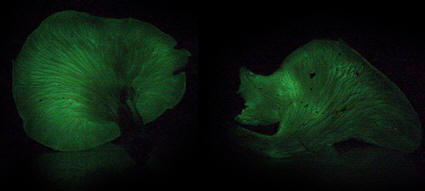
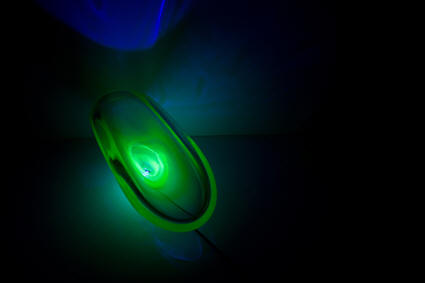

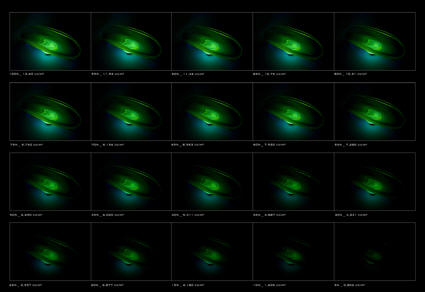
--------------
Laboratory of n[l]ight
“theBuildingWhichNeverDies (tBWND)”
This laboratory is linked to human, environmental and astronomical aspects:
- To human physiological aspects by studies of the minimum perception of light and adaptation to darkness, and of how, conversely, bright light intensity affects our metabolism. One key aspect here is dynamic light management with the ability to adapt the intensity and colour of the artificial light to the ever-changing natural lighting conditions throughout the day and night;
- To environmental aspects by a strategy of hyper-localizing the building through its ability to collect and reproduce the power of the sun in an afterglow effec
- To astronomical aspects by creating a correspondence between the location of the building and its celestial position.
- To human pathological aspect by revealing the level, rate and nature of UV crossing the stratosphere and touching the earth ground and species (weakness of Ozone layer).
The development of this observatory of n[l]ight takes account of the movement of the Earth in the celestial sphere. Its geometry is derived from several parameters:
- Its local positioning on the Les Andelys site;
- The Coriolis force acting on the four cardinal points of the location leads to the vortex-shaped design of the observatory, also taking account of the angular orientation of the earth;
- The latitude and longitude of the spherical "vault of heaven".
The building "that never dies" is dedicated both to the moon – the "aster of the night" – by tracking its position through the rotation of the building itself, and to the sun by collecting energy with phosphorescent pigments and photovoltaic cells. The afterglow will be directly influenced by the seasonal and daily intensity of the sun (UV), and by the surfaces "touched" directly by its rays. As a result, the "glowing membrane" will be in an ongoing state of flux and UV dangerousness, day after day, night after night.
This photon energy is given off again during the twilight hours and after sunset, to create an After Death Experiment (ADE) effect, in the form of an altered state of perception in the hours of darkness.
In this way, the building is affected by the two main natural sources of light: direct light from the sun, and reflected light from the moon.
Rotation
This observatory of the n[l]ight rotates to follow the moon.
Like any basic observatory system, its movement is along two axes:
1) the ground disk on the XY axis tracks the longitude;
2) the moon cone (as in a telescope) in the building adjusts the latitude in the plane XZ.
This observatory tracks the moon by day and by night, no matter if the sky is cloudy or not. When the moon is outside the cone of visibility, the building simply waits at the position where it will next reappear.
Sunset afterglow
As a laboratory, the Thorn Academy of Light "resists" the darkness of the night through the multitude of glowing lines embedded in its outer surface. The development of the green phosphorescent outdoor appearance is a direct reference to the "streaking" effect produced when the night sky is photographed with long time-exposure settings.
But at night this lab restores the light intensity of daytime by discharging UV sensor units located on all the exterior surfaces. Thus, their phosphorescent components (Isobiot®opic oxide pigment), populated on all its outdoor surfaces, report on solar activity, its degree of dangerousness according to its variations of intensity and specific nature (UV - A,B,C).
The components afterglow as a detector, an architectural Marker of the mutation of our environment and occur as a signal of UV human pathologies.
The level of UV which has crossed the Ozone layer is only revealed with a gap of time, after people are plugged into the shadows of the day, in the death of the sunset, by the after glowing ghost.
The duration of afterglow could be extended throughout the night from dusk to dawn by altering the chemical composition of the pigments in the components. To prevent the cold hindering performance in the winter, photovoltaic cells are plugged into the components to warm them (alternatively, this can be achieved by using infrared light-emitting diodes (LEDs), or silver wire resistors printed on the glass). Obviously the power of the afterglow effect will depend on the season and the intensity of the sun's rays.
Components
The glowing components include:
- a glass mould matrix
- phosphorescent pigments from “Isobiot®ope”
- photovoltaic cells for the energy of the rotating machinery.
The components are distributed over 160 m² of outer surfaces at around seven per m², making a total of 1,200 units. The total surface area of PV cells embedded in the components is approximately 100 m². They produce 15,000 kWh per annum.
Physiologial studies
1) Adaptation to Darkness
Inside, the laboratory of n[l]ight enables experiments to be conducted into the eye's adaptation to darkness. In a dark tunnel, a glow of the intensity of moonlight (0.5 lx) is given off, providing a space in which to test the physiological minimum perceptible intensity of light, and the amount of time required to perceive an environment under those lighting conditions.
For the purpose of tests, by day the power of the sun (120,000 - 50,000 lx) can be filtered, reduced and even "switched off". By night the power of moonlight (0.5 lx) can be artificially increased.
In this way, the level of urban light intensity can be adapted to the human physiology, and the level of luminous flux reduced to decrease night-time light pollution.
The gap of light intensity between the dark adaptation phenomena and the minimum psychological level for a sensation of safety and orientation, which depends on many factors such as light quality or age-dependent personal vision, will be the main field of research in this tunnel laboratory. Specifically, tests will be conducted on the three levels that characterise visual perception: photopic, mesopic and scotopic vision.
Photopic vision occurs at high light levels and is characterised by 1) cone photoreceptors, 2) low light sensitivity, 3) high acuity and 4) color vision. Scotopic vision occurs at very low light levels and exhibits 1) use of rod photoreceptors, 2) high light sensitivity, 3) poor acuity and 4) no color vision. Mesopic vision is an interface between the two (see the "Definitions" section for more details).
This gradation of light to test its physiological perception is achieved through specific lenses and filters positioned on the porous interface zones of the building (hole-of-light penetration). These interface zones between indoor and outdoor could be used to occlude or intensify the outdoor light (perhaps by dynamic gradation).
2) OLEDs + the circadian cycle
The indoor light strategy was developed around a layered "onion" concept, in which the dark tunnel transitions, incrementally, to full artificial lightness. From the dark core tunnel of the building to the bright periphery, the lighting gradient transitions from 0.5 lx to 5,000 lx.
This project is designed to integrate the OLED (organic light-emitting diodes) research of the Zumtobel Group at Durham University and the dimmable potential of OLEDs to control a light intensity range of 0.5 lx (moon) to 5,000 lx at 460 nm. This high intensity is bright enough to stop production of the hormone melatonin and influence the physiological circadian cycle.
Note: With the circadian rhythm in full swing, bright light will suppress melatonin production at night quite rapidly, while creating dark conditions in the daytime will not lead to production of the hormone.
This academy and laboratory of light will provide the opportunity to test the effects of light on the eye's adaptation to darkness and on melatonin cycles, as well as studying the physiological and psychological impacts of light. It will also permit studies of light intensity adaptation, using light sensors to create dynamic relationships and interdependencies between indoor and outdoor conditions. And it will allow tests to be conducted to identify the optimal levels and criteria of lighting with the lowest impact on energy and highest impact on night-time visibility.
3) UV Markers - Isobiot®ope & Pathology report
Isobiot®ope
The After Glowing occurs when this mineral powder is subjected to UV radiation.
Isobiot®ope powder jailed in a molded glass component (during the casting and glass) reveals through the intensity of its phosphorescence the intensity and natures of Ultra Violet ray which cross the atmosphere, and specifically the stratosphere, to touch the ground of the planet and human beings. Phosphorescence occurs as a signal, a marker of the evolution and dangerousness of the invisible biotope, with a gap of time during the absorption period and the appearance of its restitution (in the darkness). The Isobiot®ope component is a marker, a biotope detector.
Isobiot®ope is a yellow - greenish natural phosphorescent actinide powder blended mineral coming from several raw minerals (aragonite, autunite, brannérite, pechblende, phosphuranylite, renardite, uranite, vanularite, wolendorfite, zircon…)
For example:
-Autunite (hydrated calcium uranyl phosphate) with formula: Ca(UO2)2(PO4)2·10-12H2O is a yellow - greenish fluorescent mineral with a hardness of 2 - 2½. Autunite crystallizes in the tetragonal system and often occurs as tabular square crystals.
- Aragonite is a carbonate mineral, one of the two common, naturally occurring crystal forms of calcium carbonate, CaCO3. Aragonite's crystal lattice is an orthorhombic system with acicular crystals. Repeated twinning results in pseudo-hexagonal forms.
Isobiot®ope
Phosphorescence
is coming from is the emission with a gap of time of electromagnetic
radiation light by a substance that has absorbed radiation of a different
wavelength. The slower time scales of the re-emission are associated with
"forbidden" energy state transitions in quantum mechanics. However, for
light to be absorbed and emitted at these fast time scales, the energy of
the photons involved (i.e. the wavelength of the light) must be carefully
tuned according to the rules of quantum mechanics to match the available
energy states and allowed transitions of the substrate. The energy
difference between the absorbed and emitted photons is due to thermal
losses. The most striking examples of this phenomenon occur when the
absorbed photon is in the ultraviolet region of the spectrum, and is thus
invisible, and the emitted light is in the visible region. This
phosphorescent compounds have triplet lifetimes up to hours, allowing these
substances to effectively store light energy in the form of very slowly
degrading excited electron states. If the phosphorescent quantum yield is
high, these substances will release significant amounts of light over long
time scales, creating so-called "glow-in-the-dark" materials.![]() ,
where S is a singlet and T a triplet whose subscripts denote states (0 is
the ground state, and 1 the excited state). The study of phosphorescent
materials led to the discovery of radioactivity in 1896
,
where S is a singlet and T a triplet whose subscripts denote states (0 is
the ground state, and 1 the excited state). The study of phosphorescent
materials led to the discovery of radioactivity in 1896
Pathology report
Overexposure to UV radiation have
harmful effects on humans, and many pathology are triggered by the
dangerousness of the ray (such as sunburn, acute and chronic damage to the
eyes and immune system as well as various forms of skin cancer…).
-Pathology /
Skin cancer – UVB, the higher energy
UV radiation absorbed by ozone, is a contributory factor to skin cancer.
In addition, increased surface
UV leads to increased tropospheric ozone, which is a health risk to humans.
-Pathology /
Basal and squamous cell carcinomas
are the most common forms of skin cancer in humans, They are strongly linked
to UVB exposure- absorption of UVB radiation causes the pyrimidine bases in
the DNA molecule to form dimers, resulting in transcription errors when the
DNA replicates
-Pathology /
Malignant melanoma is much less
common but far more dangerous. The relationship between malignant melanoma
and ultraviolet exposure is that both UVB and UVA are involved.
90 to 95% of malignant melanomas may
be due to UVA and visible radiation.
-Pathology /
Eye damage - High intensities of UVB
light are hazardous to the eyes, and exposure can cause welder’s flash (photokeratitis
or arc eye) and may lead to cataracts, pterygium, and pinguecula formation.
UV light is absorbed by
molecules known as chromophores, which are present in the eye cells and
tissues. Chromophores absorb light energy from the various wavelengths at
different rates - a pattern known as absorption spectrum.
-Pathology /
DNA damages - UVA, UVB and UVC can
all damage collagen fibres and thereby accelerate aging of the skin.
Both UVA and UVB destroy vitamin A in
skin, which may cause further damage. UVA is known that it can contribute to
skin cancer via indirect DNA damage - free radicals and reactive oxygen
species.
It penetrates deeply but it does not cause sunburn. UVA does not damage DNA
directly like UVB and UVC, but it can generate highly reactive chemical
intermediates, such as hydroxyl and oxygen radicals, which in turn can
damage DNA.
------------------------------------------------------------------------------------
Credits: R&Sie(n) / new-territories / Francois Roche, Stephanie Lavaux, Kiuchi Toshikatsu associated to Stephan Henrich, M/M, Benoit Lalloz, with the participation of Gaetan Robillard, Sebastien Szczyrk, Gorka Arrizabalaga, Jean-Michel Castagné
&
Sandra Meireis, Ulrike Marie Steen, Gabriel Blue Cira, Hamish Rhodes, Alessandra Vassallo, Sina Momtaz, Lisa Landgard, Melissa Millot
Production (biennale) : Glass craft man, Stephane Rivoal, France /CNC Prototyper, Tecmolde, Spain / Assembling Ufacto, Paris
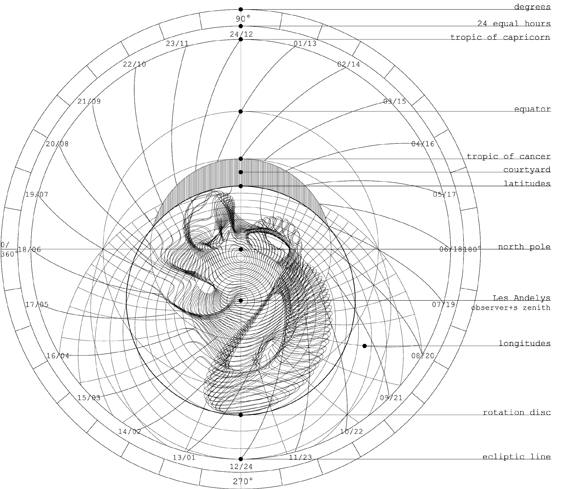
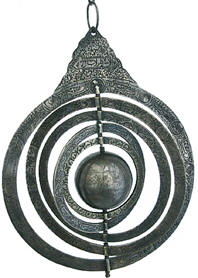
UV report
Ultraviolet (UV) light is electromagnetic radiation emitted by the Sun with a wavelength shorter than that of visible light, but longer than X-rays, in the range 10 nm to 400 nm, and energy levels from 3 eV to 124 eV. It is so named because the spectrum consists of electromagnetic waves with frequencies higher than those that humans identify as the colour violet.
UV emission’s variation - The small fraction in UV wavelengths varies by a few percent. Total solar output is now measured to vary by approximately 0.1% or about 1.3 W/m² peak-to-trough during the 11 year cycle. The amount of solar radiation received at the outer surface of Earth’s atmosphere averages 1366 W/m². The intensity of solar radiation reaching the Earth has been relatively constant throughout 2000 years, with variations of around 0.1- 0.2%. More subtle solar magnetic activity influences on climate from cosmic rays or the Sun’s uv radiation is possible.
UV and visible spectrum - All organisms’ vision is restricted to a small range of the electromagnetic spectrum; this varies from creature to creature, but is mainly between 400 and 700 nm. This is a rather small section of the electromagnetic spectrum, this probably reflects the submarine evolution of the eye: water blocks out all but two small windows of the EM spectrum, and there has been no evolutionary pressure among land animals to broaden this range.
---------------------------------------------------------------------
Ozone report
Ozone in the Earth’s stratosphere is created by ultraviolet light striking oxygen molecules containing two oxygen atoms (O2), splitting them into individual oxygen atoms; the atomic oxygen then combines with unbroken O2 to create ozone, O3. The ozone molecule is also unstable and when ultraviolet light hits ozone it splits into a molecule of O2 and an atom of atomic oxygen, a continuing process called the ozone-oxygen cycle, thus creating an ozone layer in the stratosphere, the region from about 10 to 50 km above Earth’s surface.
Ozone in the atmosphere - About 90% of the ozone in our atmosphere is contained in the stratosphere. Ozone concentrations are greatest between about 20 and 40 km, where they range from about 2 to 8 parts per million.
The thickness of the ozone layer varies by a large factor worldwide, being smaller near the equator and larger towards the poles. It also varies with season, being in general thicker during the spring and thinner during the autumn in the northern hemisphere. During winter, the ozone layer actually increases in depth. This puzzle is explained by the prevailing intra-stratospheric flux patterns, known as the Brewer-Dobson circulation. While most of the ozone is indeed created over the tropics, the stratospheric circulation then transports it pole-ward and downward to the lower stratosphere of the high latitudes. The Brewer-Dobson circulation moves very slowly. The time needed to lift an air parcel from the tropical troposphere near 16 km to 20 km is about 4–5 months.
Ozone depletion - the ozone layer can be depleted by free radical catalysts, including nitric oxide (NO), nitrous oxide (N2O), hydroxyl (OH), atomic chlorine (Cl), and atomic bromine (Br). The concentrations of chlorine and bromine have increased markedly in recent years due to the release of large quantities of man-made Organohalogen compounds, especially chlorofluorocarbons (CFCs) and bromofluorocarbons. These highly stable compounds are capable of surviving the rise to the stratosphere, where Cl and Br radicals are liberated by the action of UV light. Each radical is free to initiate and catalyze a chain reaction capable of breaking down over 100,000 ozone molecules. The breakdown of ozone in the stratosphere results in the ozone molecules being unable to absorb UV radiation. Consequently, unabsorbed and dangerous UV-B radiation is able to reach the Earth’s surface. Ozone levels, over the northern hemisphere, have been dropping by 4% per decade. Over approximately 5% of the Earth’s surface, around the north and south poles, much larger declines have been seen - the ozone holes. In 2009, nitrous oxide (N2O) was the largest ozone-depleting substance emitted through human activities.
---------------------------------------------------------------------
Isobiot®ope report
Isobiot®ope is an Ultra Violet Sensor and Marker.
The After Glowing occurs when this mineral powder is subjected to UV radiation.
Isobiot®ope powder jailed in a molded glass component (during the casting and glass) reveals through the intensity of its phosphorescence the intensity and natures of Ultra Violet ray which cross the atmosphere, and specifically the stratosphere, to touch the ground of the planet and human beings. Phosphorescence occurs as a signal, a marker of the evolution and dangerousness of the invisible biotope, with a gap of time during the absorption period and the appearance of its restitution (in the darkness). The Isobiot®ope component is a marker, a biotope detector.
Isobiot®ope is a yellow - greenish natural phosphorescent actinide powder blended mineral coming from several raw minerals (aragonite, autunite, brannérite, pechblende, phosphuranylite, renardite, uranite, vanularite, wolendorfite, zircon…)
For example:
-Autunite (hydrated calcium uranyl phosphate) with formula: Ca(UO2)2(PO4)2·10-12H2O is a yellow - greenish fluorescent mineral with a hardness of 2 - 2½. Autunite crystallizes in the tetragonal system and often occurs as tabular square crystals.
- Aragonite is a carbonate mineral, one of the two common, naturally occurring crystal forms of calcium carbonate, CaCO3. Aragonite's crystal lattice is an orthorhombic system with acicular crystals. Repeated twinning results in pseudo-hexagonal forms.
Isobiot®ope
Phosphorescence
is coming from is the emission with a gap of time of electromagnetic radiation
light by a substance that has absorbed radiation of a different wavelength. The
slower time scales of the re-emission are associated with "forbidden" energy
state transitions in quantum mechanics. However, for light to be absorbed and
emitted at these fast time scales, the energy of the photons involved (i.e. the
wavelength of the light) must be carefully tuned according to the rules of
quantum mechanics to match the available energy states and allowed transitions
of the substrate. The energy difference between the absorbed and emitted photons
is due to thermal losses. The most striking examples of this phenomenon occur
when the absorbed photon is in the ultraviolet region of the spectrum, and is
thus invisible, and the emitted light is in the visible region. This
phosphorescent compounds have triplet lifetimes up to hours, allowing these
substances to effectively store light energy in the form of very slowly
degrading excited electron states. If the phosphorescent quantum yield is high,
these substances will release significant amounts of light over long time
scales, creating so-called "glow-in-the-dark" materials.,
![]() where S is a singlet and
T a triplet whose subscripts denote states (0 is the ground state, and 1 the
excited state). The study of phosphorescent materials led to the discovery of
radioactivity in 1896
where S is a singlet and
T a triplet whose subscripts denote states (0 is the ground state, and 1 the
excited state). The study of phosphorescent materials led to the discovery of
radioactivity in 1896
---------------------------------------------------------------------
Pathology report
Overexposure to UV radiation
have harmful effects on humans, and many
pathology are triggered by the dangerousness of the ray (such as sunburn, acute
and chronic damage to the eyes and immune system as well as various forms of
skin cancer…).
Pathology /
Skin cancer –
UVB, the higher energy UV radiation
absorbed by ozone, is a contributory factor to skin cancer.
In addition, increased surface UV leads
to increased tropospheric ozone, which is a health risk to humans.
Pathology / Basal and squamous cell carcinomas are the most common forms of skin cancer in humans, They are strongly linked to UVB exposure- absorption of UVB radiation causes the pyrimidine bases in the DNA molecule to form dimers, resulting in transcription errors when the DNA replicates
Pathology / Malignant melanoma is much less common but far more dangerous. The relationship between malignant melanoma and ultraviolet exposure is that both UVB and UVA are involved. 90 to 95% of malignant melanomas may be due to UVA and visible radiation.
Pathology / Eye damage - High intensities of UVB light are hazardous to the eyes, and exposure can cause welder’s flash (photokeratitis or arc eye) and may lead to cataracts, pterygium, and pinguecula formation. UV light is absorbed by molecules known as chromophores, which are present in the eye cells and tissues. Chromophores absorb light energy from the various wavelengths at different rates - a pattern known as absorption spectrum.
Pathology /
DNA damages
- UVA, UVB and UVC can all damage collagen fibres and thereby accelerate aging
of the skin. Both UVA and UVB
destroy vitamin A in skin, which may cause further damage. UVA is known that it
can contribute to skin cancer via indirect DNA damage - free radicals and
reactive oxygen species.
It penetrates deeply but it does not cause sunburn. UVA does not damage DNA
directly like UVB and UVC, but it can generate highly reactive chemical
intermediates, such as hydroxyl and oxygen radicals, which in turn can damage
DNA.